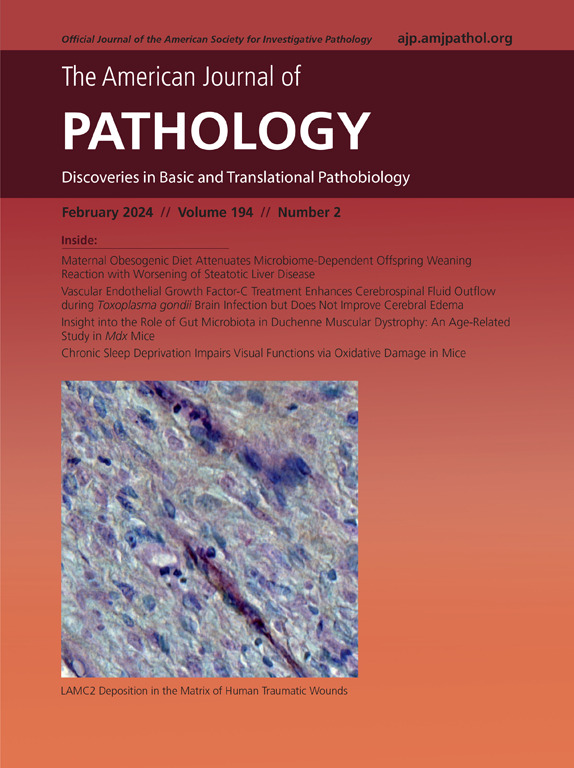FKBP10沉默通过HSP47/SMAD3通路失活抑制纤维化和恢复自噬减轻臀肌挛缩
IF 3.6
2区 医学
Q1 PATHOLOGY
引用次数: 0
摘要
纤维化驱动GMC进展,FKBP脯氨酸异构酶10 (FKBP10)起关键作用。本研究旨在探讨FKBP10调控GMC的分子机制。分析FKBP10、HSP47、SMAD3、自噬和纤维化相关指标的表达水平的相关性。组织学染色用于评估组织损伤和纤维化。采用甲醇青霉素注射法建立GMC大鼠模型。FKBP10与HSP47的相互作用也被检测到。结果显示,FKBP10在GMC患者和大鼠臀肌中表达上调,并伴有明显的损伤和纤维化。tgf - β1、α-SMA、I型胶原、III型胶原、vimentin、纤维连接蛋白、p62和LC3水平升高,MMP9和LC3II/I、Beclin 1、p62和ATG7水平降低,表明自噬减弱。FKBP10的表达与自噬指标呈负相关,与HSP47和纤维化指标呈正相关。发现FKBP10与HSP47相互作用。敲低FKBP10可下调HSP47和p-SMAD3/SMAD3的水平。此外,FKBP10、HSP47和雷帕霉素(RAPA)的下调部分逆转了tgf - β1诱导的效应。相反,3-甲基腺嘌呤(3-MA)和HSP47过表达增强了tgf - β1诱导的效应。在GMC大鼠中,FKBP10敲低可降低组织损伤和纤维化,逆转HSP47、p-SMAD3/SMAD3、纤维化和自噬指标水平,降低自噬和LC3水平。综上所述,沉默FKBP10使HSP47/SMAD3信号通路失活,抑制纤维化,改善自噬缺陷,从而减轻GMC。本文章由计算机程序翻译,如有差异,请以英文原文为准。

FKBP10 Silencing Alleviates Gluteal Muscle Contracture by Inhibiting Fibrosis and Restoring Autophagy via HSP47/SMAD3 Pathway Inactivation
FKBP prolyl isomerase 10 (FKBP10) plays a key role in fibrosis-driven progression of gluteal muscle contracture (GMC). This study investigated the molecular mechanism of FKBP10 in GMC progression. Expression levels of FKBP10, heat shock protein 47 (HSP47), SMAD3, autophagy, and fibrosis-related indicators were analyzed for correlations. The GMC rat model was constructed by injecting methanol penicillin. The interaction between FKBP10 and HSP47 was also assessed. FKBP10 expression was up-regulated in the gluteal muscle of patients with GMC and rats, accompanied by obvious damage and fibrosis. Elevated levels of transforming growth factor beta 1 (TGF-β1), α-smooth muscle actin (α-SMA), collagen I, collagen III, vimentin, fibronectin, p62, and LC3, along with decreased levels of matrix metalloproteinase-9 and LC3II/I, Beclin 1, p62, and ATG7, indicated weakened autophagy. FKBP10 expression correlated negatively with autophagy indicators and positively with HSP47 and fibrosis indicators. FKBP10 interacted with HSP47. Knockdown of FKBP10 down-regulated the levels of HSP47 and phosphorylated SMAD3/SMAD3. Furthermore, knockdown of FKBP10, HSP47, and rapamycin partially reversed the TGF-β1–induced effect. Conversely, 3-methyl adenine and HSP47 overexpression enhanced TGF-β1–induced effects. In GMC rats, FKBP10 knockdown reduced tissue damage and fibrosis, reversed HSP47, phosphorylated SMAD3/SMAD3, fibrosis, and autophagy indicator levels, and reduced autophagy and LC3 levels. In summary, silencing FKBP10 inactivated the HSP47/SMAD3 signaling pathway, inhibited fibrosis, and ameliorated autophagy defects, thereby alleviating GMC.
求助全文
通过发布文献求助,成功后即可免费获取论文全文。
去求助
来源期刊
CiteScore
11.40
自引率
0.00%
发文量
178
审稿时长
30 days
期刊介绍:
The American Journal of Pathology, official journal of the American Society for Investigative Pathology, published by Elsevier, Inc., seeks high-quality original research reports, reviews, and commentaries related to the molecular and cellular basis of disease. The editors will consider basic, translational, and clinical investigations that directly address mechanisms of pathogenesis or provide a foundation for future mechanistic inquiries. Examples of such foundational investigations include data mining, identification of biomarkers, molecular pathology, and discovery research. Foundational studies that incorporate deep learning and artificial intelligence are also welcome. High priority is given to studies of human disease and relevant experimental models using molecular, cellular, and organismal approaches.

 求助内容:
求助内容: 应助结果提醒方式:
应助结果提醒方式:


